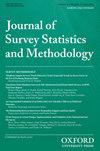Text Messages to Facilitate the Transition to Web-First Sequential Mixed-Mode Designs in Longitudinal Surveys
IF 1.6
4区 数学
Q2 SOCIAL SCIENCES, MATHEMATICAL METHODS
引用次数: 0
Abstract
This article is concerned with the transition of a longitudinal survey from a single-mode design to a web-first mixed-mode design and the role that text messages to sample members can play in smoothing that transition. We present the results of an experiment that investigates the effects of augmenting the contact strategy of letters and emails with text messages, inviting the sample members to complete a web questionnaire and reminding them of the invite. The experiment was conducted in a subsample of Understanding Society, a household panel survey in the United Kingdom, in the wave that transitioned from a CAPI-only design to a sequential design combining web and CATI. In the experiment, a quarter of the sample received letters and emails, while the rest received between one and three text messages with a personalized link to the questionnaire. We examine the effect of the text messages on response rates, both at the web phase of a sequential design and at the end of the fieldwork after a CATI follow-up phase, and explore various mechanisms that might drive the increase in response rates. We also look at the effects on the device used to complete the survey and field efforts needed at the CATI stage. The findings indicate that text messages did not help to significantly increase response rates overall, although some subgroups benefited from them, such as panel members who had not provided an email or postal address before. Likewise, the text messages increased web completion among younger panel members and those with an irregular response pattern. We only found a slight and nonsignificant effect on smartphone use and no effect on the web household response rate, a proxy for fieldwork efforts.短信促进纵向调查向网络优先混合模式设计过渡
本文关注的是纵向调查从单一模式设计向网络优先混合模式设计的过渡,以及向样本成员发送文本信息在平滑过渡中所能发挥的作用。我们介绍了一项实验的结果,该实验研究了用短信加强信件和电子邮件的联系策略、邀请样本成员完成网络问卷并提醒他们注意邀请的效果。该实验是在英国家庭面板调查 "了解社会 "的一个子样本中进行的,该调查从纯 CAPI 设计过渡到了结合网络和 CATI 的顺序设计。在实验中,四分之一的样本收到了信件和电子邮件,而其余的样本则收到了一到三条带有问卷个性化链接的短信。我们研究了短信对回复率的影响,无论是在顺序设计的网络阶段,还是在 CATI 跟踪阶段后的实地调查结束时,并探讨了可能导致回复率提高的各种机制。我们还研究了完成调查所使用的设备和 CATI 阶段所需的实地工作的影响。研究结果表明,短信并没有帮助显著提高整体回复率,尽管一些子群体从中受益,例如之前没有提供电子邮件或邮寄地址的小组成员。同样,短信也提高了较年轻的小组成员和回复模式不规则的小组成员的网络完成率。我们只发现短信对智能手机的使用略有影响,但并不显著,而对代表实地工作的网络家庭回复率则没有影响。
本文章由计算机程序翻译,如有差异,请以英文原文为准。
求助全文
约1分钟内获得全文
求助全文
来源期刊
CiteScore
4.30
自引率
9.50%
发文量
40
期刊介绍:
The Journal of Survey Statistics and Methodology, sponsored by AAPOR and the American Statistical Association, began publishing in 2013. Its objective is to publish cutting edge scholarly articles on statistical and methodological issues for sample surveys, censuses, administrative record systems, and other related data. It aims to be the flagship journal for research on survey statistics and methodology. Topics of interest include survey sample design, statistical inference, nonresponse, measurement error, the effects of modes of data collection, paradata and responsive survey design, combining data from multiple sources, record linkage, disclosure limitation, and other issues in survey statistics and methodology. The journal publishes both theoretical and applied papers, provided the theory is motivated by an important applied problem and the applied papers report on research that contributes generalizable knowledge to the field. Review papers are also welcomed. Papers on a broad range of surveys are encouraged, including (but not limited to) surveys concerning business, economics, marketing research, social science, environment, epidemiology, biostatistics and official statistics. The journal has three sections. The Survey Statistics section presents papers on innovative sampling procedures, imputation, weighting, measures of uncertainty, small area inference, new methods of analysis, and other statistical issues related to surveys. The Survey Methodology section presents papers that focus on methodological research, including methodological experiments, methods of data collection and use of paradata. The Applications section contains papers involving innovative applications of methods and providing practical contributions and guidance, and/or significant new findings.

 求助内容:
求助内容: 应助结果提醒方式:
应助结果提醒方式:


